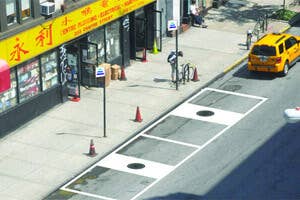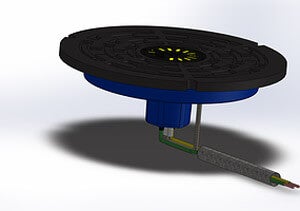New York Manhole Covers To Deliver Power to Electric Vehicles
New York startup HEVO has come up with a clever way to make EV charging more convenient in urban environments. Reserved parking spots feature what look like manholes in the pavement, but are in fact wireless charging devices that will give the trucks a little more juice while they sit.

Share
Electric vehicles are a pretty good solution for the very serious problem of particulate and carbon pollution that cars and trucks pour into the air. But adoption has been slow because drivers aren’t willing to risk running out of juice mid-trip. Until charging stations are nearly as easy to find as gasoline, the problem of vehicular pollution will remain stalled.
New York startup HEVO is offering one clever improvement, making it easier to recharge electric vehicles, or EVs, in cities. It's offering reservable parking spots featuring what look like manholes in the pavement, but are in fact wireless charging devices that will give the trucks a little more juice while they sit.
Wireless charging eliminates the clumsiness of cords in a crowded city environment. And because the parking spaces can be reserved, they reduce the chances that delivery truck drivers will rack up costly parking tickets.
But, no, a few minutes of charging while the driver unloads a couple dollies of office supplies or soda will not fully charge a truck.
Using induction, the system provides, 220-volts and up to 10 kilowatts of energy from the pad to the vehicle. (Each vehicle must have installed a 10-pound receiver along the drive train to absorb the power.) Ten hours of charge will provide about 175 miles of travel, according to HEVO.
South Korea recently began a pilot program that charges municipal buses directly from the road using similar wireless technology.
Be Part of the Future
Sign up to receive top stories about groundbreaking technologies and visionary thinkers from SingularityHub.


HEVO also provides a mobile app that shows drivers where the charging spots are and helps guide them into position directly over the pads. It also handles billing and payments.
No fleet? That’s okay; individuals will also be able to install a charging station at their home or reserved parking spot.
HEVO plans to open its first two charging stations early next year in lower Manhattan, servicing New York University's fleet, according to a Wired report.
Images: Brandon Bourdages via Shutterstock.com, HEVO
Cameron received degrees in Comparative Literature from Princeton and Cornell universities. He has worked at Mother Jones, SFGate and IDG News Service and been published in California Lawyer and SF Weekly. He lives, predictably, in SF.
Related Articles

Startup Zap Energy Just Set a Fusion Power Record With Its Latest Reactor

Scientists Say New Air Filter Transforms Any Building Into a Carbon-Capture Machine

Investors Have Poured Nearly $10 Billion Into Fusion Power. Will Their Bet Pay Off?
What we’re reading


